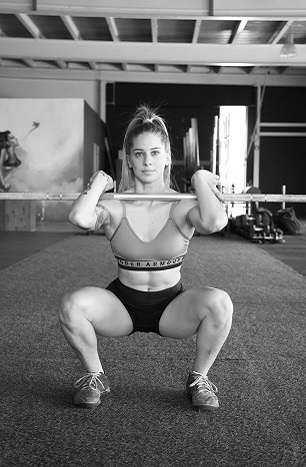Squatting is a multijoint strength training movement which effectively recruits multiple muscle groups at once, and which is considered to be one of the most functional and efficient weight bearing exercises. The major muscles involved during a squat are the quadriceps, hamstrings, gastrocnemius, and the gluteus maximus (Beachle & Earle, 2000). Additionally, the squat relies on hip and ankle joint muscle activity and recruits the abdominals and spinal erectors, as well, which need to be activated throughout the movement in order to avoid injuries.
How to execute the front squat:
Place the bar securely on your upper chest and shoulders (anterior deltoits & clavicles specifically), with elbows high. Establish a clean grip width (bar outside your shoulders). This grip may need to be adjusted, depending on wrist, elbow, and shoulder flexibility or mobility.
Establish a stable tripod foot (heel, base of the first toe and base of the fifth toe in contact with the ground while creating a good arch in the foot).
Generate external rotation torque at the hips (verbal cue: squeeze your glutes). Make sure that the knees are aligned with your toes. The feet can point slightly outwards and at hip width stance. How wide the stance is always depends on the anatomy, anthropomentric characteristics (i.e. height/hip width ratio and torso length), and level of mobility of the individual (Caruso et al., 2009). Make sure to stand in a comfortable to you position!
Create a rigid trunk by taking a big breath and holding it tight (use your diaphragm properly).
Slightly hip hinge to engage the posterior chain, mainly the glutes.
Keep the bar over the midfoot during the entire squat.
Maintain an upright chest position with the elbows raised high throughout the movement. If you lack mobility at the shoulder or thoracic spine you might be unable to keep that high elbow position. Work on your mobility as well! Push your knees out throughout the movement (to avoid valgus collapse).
If you are a competitive weightlifter, or have years of experience with lifting, then make sure that your hips descent to the greatest depth possible. This will help you gain the required strength at the bottom position of a snatch or clean. However, if you are not that experienced start by descending up to the level that feels comfortable to you and slowly progress to a full squat.
Make sure that you have gained a solid and stable bottom position before starting the ascend. Never allow your back to round. Keep an upright position (upright trunk), the exact position you had during your descend. Push through the heels, but always keep whole foot to the ground. Don’t forget to keep the big toe grounded as it plays a major role on glute activation!
(Horschig, 2016, Evert, 2016)
When is the front squat recommended:
Research suggests that the front squat may be advantageous compared with back squats for individuals with knee problems such as meniscus tears, and for long-term joint health. The front squat was found to be as effective as the back squat in terms of overall muscle recruitment, with significantly less compressive forces and extensor moments (Gullett et al., 2009).
Also, an athlete dealing with back pain may benefit from using the front squat variation instead of the back squat. That’s because the front squat places less torque on the lower back compared to back squat variations. However, the athlete needs to be able to perform the front squat with proper technique (acceptable thoracic spine mobility and core control), otherwise he won’t benefit from it (Horschig, 2016).
My advice: Add variety to your training. Start by mastering the bodyweight squat, then progressively move on to other variations such as weighted back squats, front squats and split squats. Always have in mind what works best for you and your goals!
